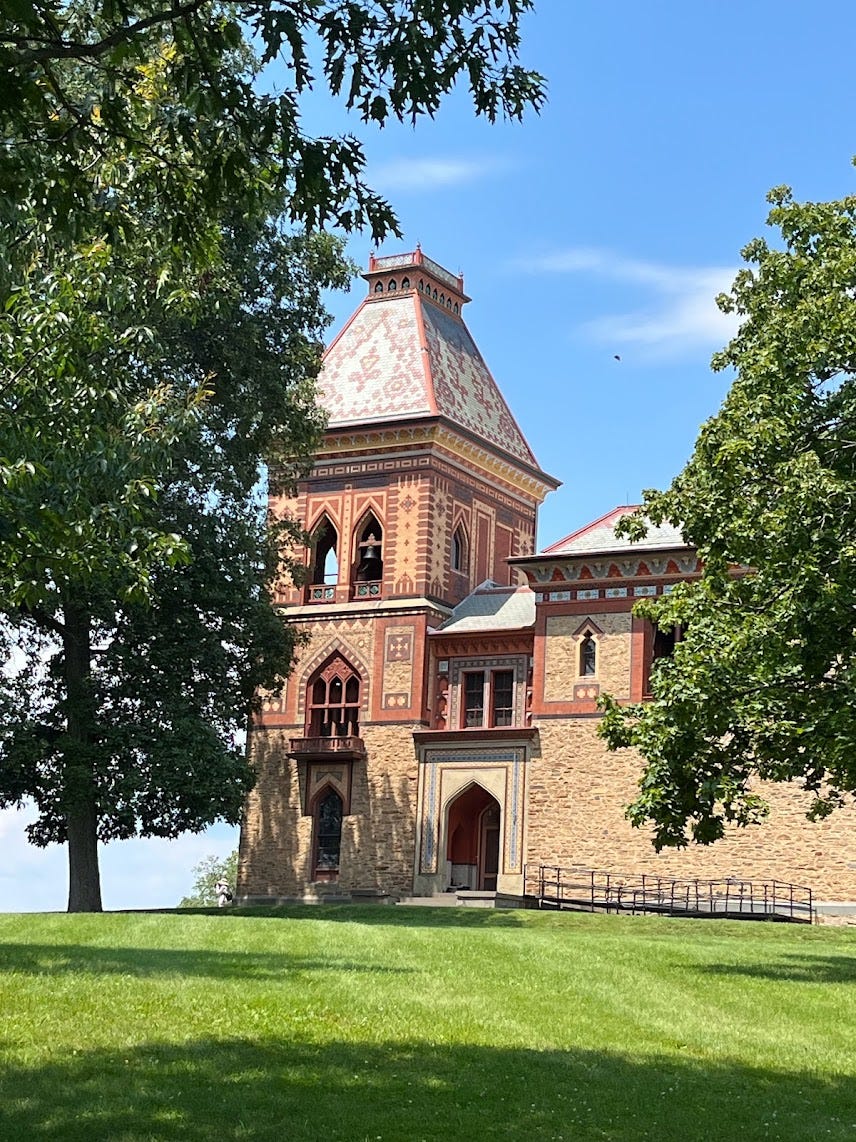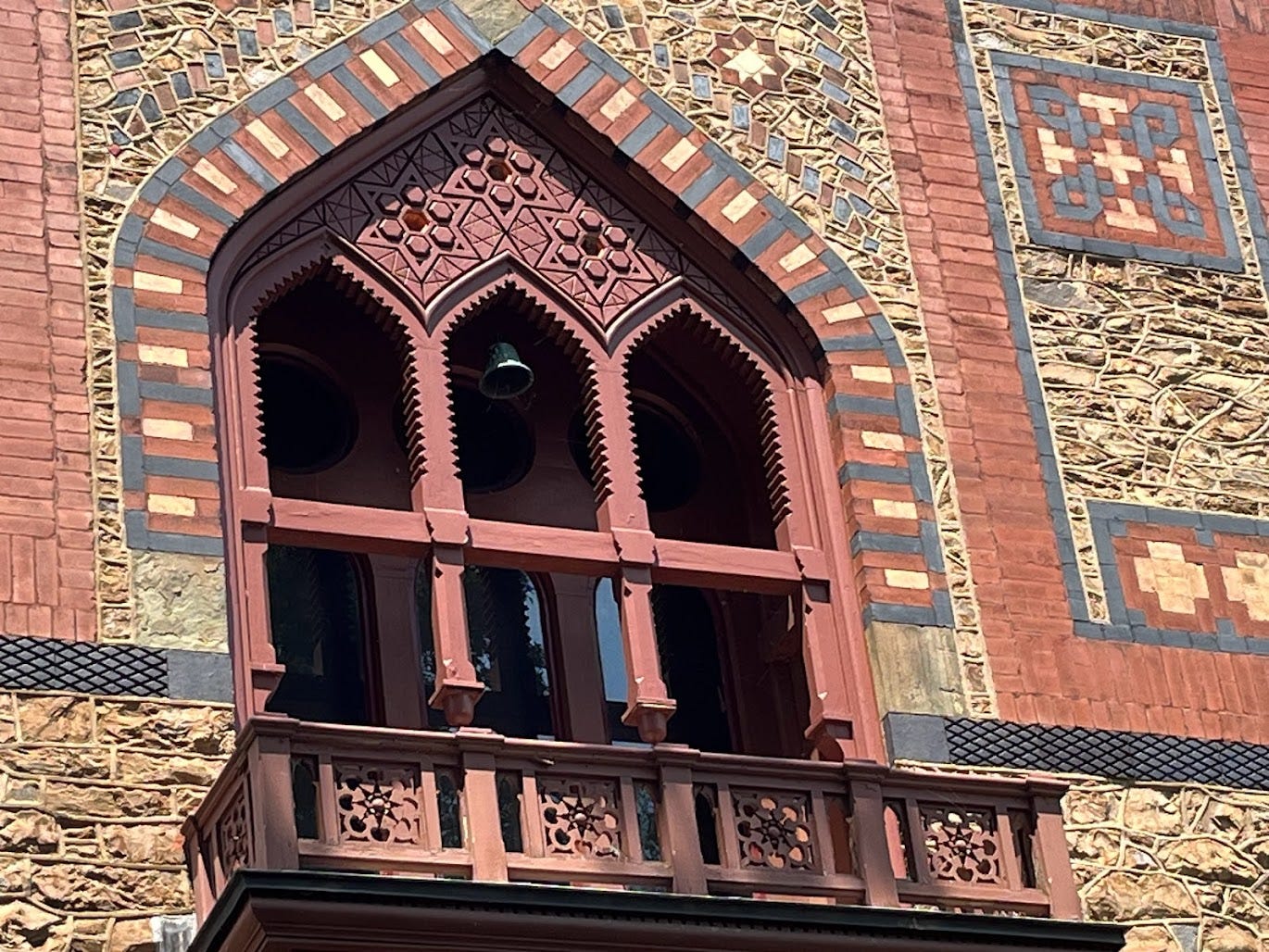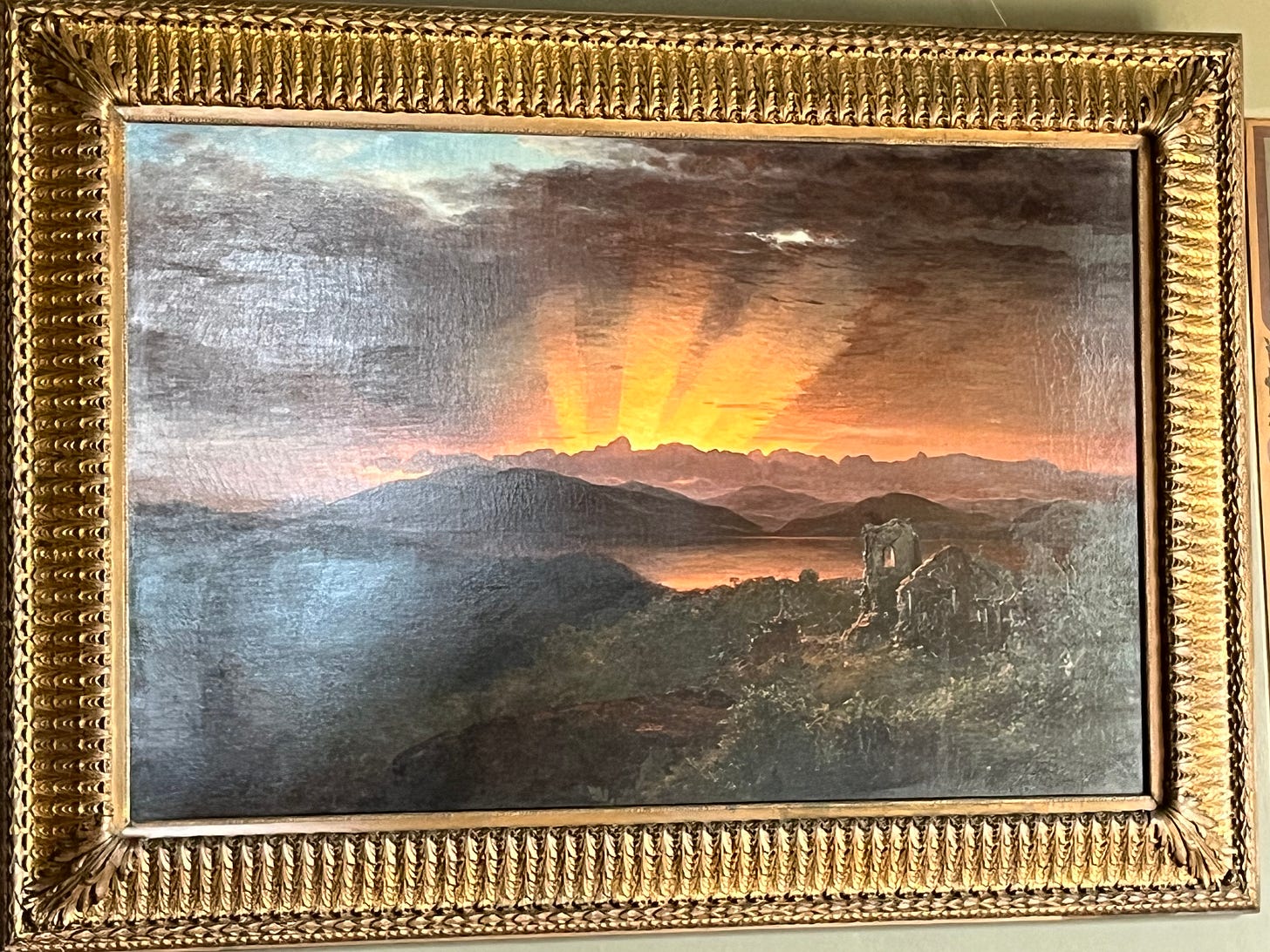A Tale of Two Motivations: Spite Vs. Love
One building constructed out of spite, and one out of love, how I went viral by tweeting about Thoreau and burritos, a fantastic story collection, and a new class I'm teaching.
I took a trip to the East Coast this month, and I brought back a story for you. While in upstate New York, I visited Olana, the remarkable home of Hudson River School landscape artist Frederic Church. Before we entered the house, our tour guide pointed to a spot in the hills where he said the Catskill Mountain House once stood. It was a prosperous hotel catering to the wealthy, visited by presidents Grant, Arthur, and Theodore Roosevelt. But in 1880, a lawyer from Philadelphia named George Harding entered the dining room with his daughter Emily, and she asked for a dish that was not on the menu: fried chicken.
The waiter insisted they couldn’t prepare fried chicken. Harding, his ire growing, asked to speak to the manager. The owner, Charles Beach, stepped in to try to calm Harding, but could not make fried chicken appear out of thin air. According to my tour guide, Beach told Harding, “If you don’t like what’s on the menu here, open your own place.”
Harding, seething, did just that. Within a year, Harding had constructed a rival mountain house, the Hotel Kaaterskill. By then the kerfuffle had a name, “The Fried Chicken War.” Harding made sure Beach noticed his gesture, by building an enormous hotel, big enough to accommodate 612 guests. According to the New York Times, the Hotel Kaaterskill served so much fried chicken that it caused a regional chicken shortage. Spite proved to be a tremendous motivator for Harding.
Both men died in 1902, the Catskill Mountain House fell into disrepair, and over conservationists’ objections, the New York Conservation department burned it in 1962. As for the Hotel Kaaterskill, it burned too, in 1924, as though it could not survive long after the force behind the spite that had engendered it had died.
After telling this story, the guide led us into Olana, a home with an altogether different motivation behind its construction: love. At a young age, Frederic Church, born in 1826, displayed an uncanny ability to paint landscapes with accuracy, detail, and emotion. After studying with acclaimed landscape artist Thomas Cole when he was 18, Church’s career launched. He began to display his paintings in New York City.
In 1859, Church featured his most famous painting, “The Heart of the Andes,” in a single-painting exhibition, charging visitors a quarter to see it. The public swooned over it. Mark Twain praised it. One visitor wrote that upon seeing the painting, “women felt faint. Both men and women succumb[ed] to the dizzying combination of terror and vertigo that they recognize[d] as the sublime.” More than 12,000 people paid 25 cents to see the painting, including a young woman who caught Church’s eye, Isabel Mortimer Carnes.
A year later, Isabel and Frederic married. Frederic was rolling in cash by this time, and he purchased the land to build Olana, a grand house whose architecture and decoration was inspired by his world travels. Isabel and Frederic had their first two children, Herbert and Emma. When Herbert was born, Frederic painted “Sunrise” (top, below) and when Emma was born, he painted “Moonrise” (bottom, below).
But when Herbert was two and Emma was five months old, the family went to New York City, where the kids caught diphtheria and died. Devastated, Isabel and Frederic traveled to Jamaica for six months. While there, he painted “Sunset, Jamaica,” with its gorgeous colors and haunting ruins in the foreground (below). According to my tour guide, Church wrote to his father that the painting was intended to express a message of hope, that even after a grave loss, an appreciation of beauty is still possible.
Frederic and Isabel had four more children, who lived to adulthood. They lived a long and prosperous life together, with Isabel dying in 1899, and Frederic following her in 1900. And why, in the end, was Olana preserved, with furnishings, paintings, and artifacts kept intact? That too is a story of love and generosity.
The Churches’ youngest son Louis lived with his wife Sally in Olana until he died in 1943, keeping everything basically intact. Sally lived until she was 96, dying in 1964. They had no children, so Olana passed to Sally’s nephew, who planned to auction everything in it off and perhaps raze the house and sell the land.
In the 1960s, few were interested in the Hudson River School painters, but a young art scholar, David Huntington, was determined to preserve Olana. Sally had allowed Huntington to visit Olana to study Church’s paintings and the surrounding landscape for his dissertation. Huntington approached Olana’s new owner to appeal to him to preserve this important piece of art history. The new owner wanted money, fast, but Huntington’s plea moved him enough that he allowed Huntington one year to raise $470,000. Through a massive, coordinated effort, Huntington attracted publicity and donations for the cause. Jackie Kennedy became involved. In the end, the state of New York supplied the final chunk of money needed to purchase Olana.
And that’s how this monument to love and beauty still stands, so you can visit it today, long after the fried chicken palace in the hills, built out of pure spite, burned to the ground.
The Assorted Whimsy Portion of The Tumbleweed
As the three of you reading this deep into The Tumbleweed know, I am America’s best kept literary secret, so it was a great shock to me when a tweet of mine went viral last week.
I have been touring literary spots and sharing notes about them on Twitter for over a decade now. I’ve got proof. Here’s one of my impressions from Austin’s O. Henry museum in 2013:
Not a single person liked that O. Henry tweet! (Even though the quantity of bourbon O. Henry could guzzle is notable.) In the days before Elon took over Twitter, my tweets used to max out at two-dozen likes. Since Elon, if I’m lucky I get up to three. But somehow, Elon pulled a lever at Twitter headquarters and 1.1 million people saw my tweet. Many people who were passionate about its subject debated each other with vigor in the replies. It was all somewhat astonishing.
Of all the sentences I’ve written in my life, those two sentences were read by the most people. One of those sentences is book-related, and the other is burrito-related, so I guess I can live with that.
The Book Recommendation Portion of The Tumbleweed
I have a great recommendation for a book to read as the summer wanes: Site Fidelity, the debut short story collection by Claire Boyles. If you love Annie Proulx, Thomas McGuane, and Rick Bass’s stories that show the way the landscape of the American West is intertwined with its people, you have to check out Boyles’ moving and lovely stories. To my delight, several of the characters reappear in various stories throughout the collection, including a trio of sisters, one of whom is a nun.
I underlined many passages, and I especially loved this one, from the story “Sister Agnes Mary in the Spring of 2012":
“Sister returns to the candle glow of the vestibule off the main sanctuary. She does not know whether to expect a blessing or a punishment. The silence sits still in the chapel air, breaks into particulates, clings like incense smoke. At dawn, there is a mini-Mardi Gras moment when sunlight streams through the stained-glass windows and lights the hard wooden pews with flecks of purple, gold, green. This beauty is neither miracle nor God’s voice. Sister sees this beauty every day, like the sunrise, no matter how she behaves.”
You don’t have to take my word for how good this collection is—Boyles won the prestigious Whiting Award and the High Plains Book Award, and Site Fidelity was a finalist for many other honors.
The Happenings & Links Portion of The Tumbleweed
My essay “Three Wishes” appears in the new issue of Hunger Mountain Review. It’s about how my grandparents lost the family farm in Nebraska during the 1980s farm crisis, and what the farm meant to me.
At Lighthouse Writers Workshop, I’ll be teaching the four-week Fiction Four Pack: Basic Craft Essentials class starting August 14. We’ll meet on Mondays at 6:30-8:30 pm at the new Lighthouse Denver HQ (no class on Labor Day). Check the link for details!
From July 21 to 30 I’ll be teaching in the Mile High MFA summer residency, and participating in a reading with Erika Krouse and Mathangi Subramian on July 25. It’s free and open to the public, at Regis University’s Claver Hall, 5-6 pm (Denver).
I am delighted to participate in Andrew McFadyen-Ketchum’s Some Kind of Wonderful Literary Jamboree on Thursday, July 27 at River Bar and Gallery
The readers will include Ruth Ellen Kocher, Wayne Miller, Eleanor Swanson, Hugh Martin, Nancy Stohlman, David J. Daniels, Lindsey Royce, Ahja Fox and my amazing Regis colleague, poet Carolina Ebeid. Festivities will start at 7 pm, and it’s free!
On Saturday, September 30, I’ll be participating in the Counterpath Indie Press Author Meet and Greet at Counterpath Press in Denver, along with many other writers with books published with small presses. The talented writer Hillary Leftwich is organizing it. Watch this space for more details.
As always, The Tumbleweed welcomes your questions and comments about writing, reading, taco eating, the Denver Nuggets, rabbit wrangling, Deion Sanders, and baby seals.













I’m not on Twitter and want to hear more of this comment kerfuffle. Maybe it’s not as notable as O Henry’s impressive bourbon absorption but notable nonetheless.